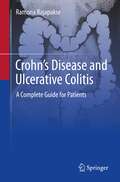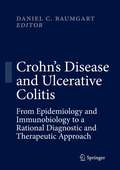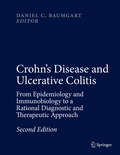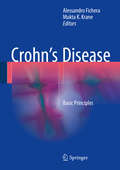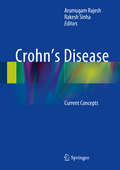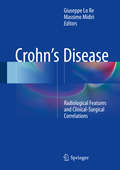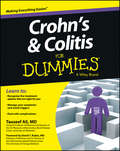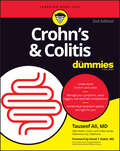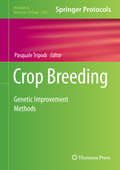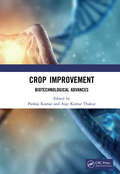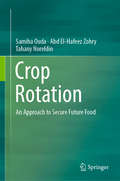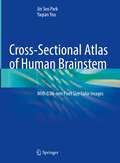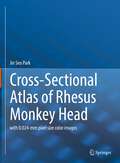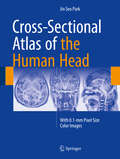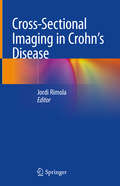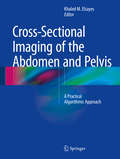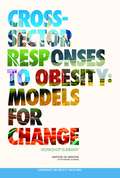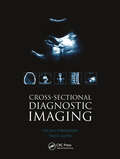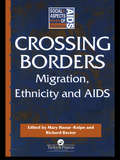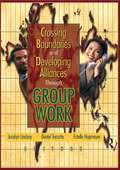- Table View
- List View
Crohn's Disease and Ulcerative Colitis: A Complete Guide for Patients
by Ramona RajapakseThis book provides a complete overview of Crohn’s disease and ulcerative colitis for the general reader. Written for patients, their friends and families, and any medical or non-medical persons who wish to learn more about Inflammatory Bowel Disease (IBD), it explains the science in clear, accessible language. The book covers the most current and comprehensive information about potential causes, clinical features, diagnosis, and treatment of IBD, including surgical options. Individual chapters are dedicated to special patient populations like pediatric patients, pregnant women, and the elderly. It also includes information about alternative therapies, as well as guidance regarding managing treatment costs for patients with financial or insurance difficulties. Featuring hand-drawn illustrations, references for further reading, and other useful resources, this book is a must-read for patients and others seeking to understand inflammatory bowel disease.
Crohn's Disease and Ulcerative Colitis: From Epidemiology and Immunobiology to a Rational Diagnostic and Therapeutic Approach
by Daniel C. BaumgartThe conditions of Crohn's disease and ulcerative colitis are excellent examples of how the exponential growth of knowledge in biomedical science can make a remarkable impact on clinical practice and patient's quality of life. It has led to the development of unique novel immunomodulatory treatments. These are continuously being refined to treat not only the two original conditions in the gut, but the systemic immunologic illness with its associated extraintestinal disorders. New therapies are sometimes complex and associated with important risks requiring a deeper understanding of their molecular principles from clinicians. Crohn's Disease and Ulcerative Colitis serves as a unique combined resource for physicians and scientists addressing the needs of both groups. It will stimulate exchange and collaboration and shorten the path between discovery and application of new knowledge and also help clinicians understand new therapeutic concepts from their origins. This volume provides an introduction to mucosal immunology which forms the basis of modern immunotherapy. It also serves as a comprehensive guide to the current diagnostic modalities, including enhanced imaging techniques such as MRI and CT enterography, virtual colonoscopy, ultrasound, and endomicroscopy as well as conventional and complex immunomodulatory principles. Each chapter is written by experts in their field and includes the most up to date information. Crohn's Disease and Ulcerative Colitis will be of great value to gastroenterologists, surgeons, internists, pediatricians and gynecologists trainees, as well as all those involved in Crohn's disease, ulcerative colitis and related autoimmune disorders.
Crohn's Disease and Ulcerative Colitis: From Epidemiology and Immunobiology to a Rational Diagnostic and Therapeutic Approach
by Daniel C. BaumgartThis new edition is a unique combined resource for physicians and scientists addressing the needs of both groups. In addition to stimulating exchange and collaboration and shortening the path between discovery and application of new knowledge, the book helps clinicians understand new therapeutic concepts from their origins. The volume serves as a comprehensive guide to the current diagnostic modalities, including enhanced imaging techniques such as MRI and CT enterography, virtual colonoscopy, ultrasound, and endomicroscopy, as well as conventional and complex immunomodulatory principles. The latest edition also includes revised chapters from the previous edition, as well as new chapters reflecting current developments in the field. Written by experts in their field, Crohn's Disease and Ulcerative Colitis: From Epidemiology and Immunobiology to a Rational Diagnostic and Therapeutic Approach, Second Edition is of great value to gastroenterologists, surgeons, internists, pediatricians and gynecologists trainees, as well as all those involved in Crohn's disease, ulcerative colitis, and related autoimmune disorders.
Crohn's Disease: Basic Principles
by Alessandro Fichera Mukta K. KraneCrohn's Disease: Basic Principles provides a comprehensive and state-of-the-art overview of the current diagnosis and treatment strategies for Crohn's disease. Care of these patients and clinical conditions can be quite complex and often require a multidisciplinary approach. Sections of the book are based on the most current, evidenced-based resources and have been structured to review the etiology and diagnosis of Crohn's disease, discuss advances in medical and surgical treatment, illustrate emerging technologies impacting the care of patients with Crohn's disease, and examine functional and quality of life outcomes in this patient population. The text reviews our understanding of the influence of molecular and genetic factors in the development and pattern of Crohn's disease. Current methods of diagnosis and strategies in the medical management of patients with Crohn's disease are evaluated including the use of biologic agents. Resection and bowel sparing techniques for primary and recurrent disease as well as advances in endoscopy and laparoscopy are discussed in detail. In addition, factors influencing the quality of life of patients with Crohn's disease are examined including nutrition, enterostomal care, fertility, and sexual function. Written by recognized experts in their field, Crohn's Disease: Basic Principles highlights the integrated multidimensional aspect of caring for patients with Crohn's disease and will be of great value to colon and rectal surgeons, general surgeons, gastroenterologists, internists, as well as fellows and upper level residents in training training.
Crohn's Disease: Current Concepts
by Arumugam Rajesh Rakesh SinhaThis book will incorporate a multimodality approach toward inflammatory bowel diseases. Up to date imaging methodologies will be described along with their strengths and weaknesses that will help in providing a rational diagnostic strategy for clinical, surgical and support teams working with these patients. Advances in medical and surgical treatment would be detailed and these would be useful to readers and professionals keen to implement these techniques in their own clinical practice.
Crohn's Disease: Radiological Features and Clinical-Surgical Correlations
by Giuseppe Lo Re Massimo MidiriThis book describes and illustrates the radiological findings that are characteristic of Crohn's disease and correlates these appearances with clinical and surgical findings in order to assist the reader in implementing an appropriate diagnostic approach in this complex disease, which often differs from patient to patient. All of the modern imaging modalities and techniques are covered, including ultrasound, multidetector row computed tomography (MDCT), magnetic resonance imaging (MRI), and combinations of MDCT and MRI with enteroclysis and enterography. The current value of X-ray and the role of endoscopy are also examined. Care is taken to cover specific patient groups, including pediatric patients, those with perianal disease or anal fistulas, and patients who have undergone surgery. In addition to surgical approaches, including minimally invasive options, other new therapies are discussed. The book will be invaluable for diagnostic radiologists, gastroenterologists, and surgeons.
Crohn's Disease: The Complete Guide to Medical Management
by Gary R. LichtensteinCrohn’s Disease: The Complete Guide to Medical Management serves as the definitive source for medical management of Crohn’s Disease (CD).Dr. Gary R. Lichtenstein, along with Dr. Ellen J. Scherl, have collaborated with over 60 experts from around the world to provide gastroenterologists and those in training with the necessary information to successfully manage the patient with Crohn’s disease. Sections Include:• Generalo The role of the FDA in drug development; pediatric considerations; disease modifiers; and more• Medicationso Antibiotic use in treatment of CD; oral budesonide; infliximab; novel biological and non biologic therapies for CD; and more• Specific Clinical Scenarioso Management of steroid unresponsive CD; management of enteric fistulae; use of pre- and probiotics; medical management of short bowel syndrome; maintenance therapy of CD; and moreFeatures:• Color images, graphs, and tables• Extensive index that includes cross-referencing to Ulcerative Colitis: The Complete Guide to Medical Management• An appendix on Infliximab treatment• Comprehensive references at the end of each chapterOrganized into an easy-to-reference format, Crohn’s Disease: The Complete Guide to Medical Management threads theory into practice and provides Gastroenterology professionals with the most comprehensive information available on this disease state.The other side of inflammatory bowel disease is covered in Drs. Gary R. Lichtenstein and Ellen J. Scherl’s Ulcerative Colitis: The Complete Guide to Medical Management. All gastroenterologists will find both books to be essential for future practice in the treatment and care of their patients with either Crohn’s disease or ulcerative colitis, as well as in the overall management of those with inflammatory bowel disease.
Crohn's and Colitis For Dummies
by Tauseef Ali David T. RubinThe ultimate reference for those with Crohn's and colitis and their family and friendsCrohn's disease and colitis are frustrating, often debilitating gastrointestinal diseases that can have a severe impact on the overall health of those who suffer from them. According to the latest estimates, more than 600,000 patients in North America have Crohn's disease. Written by a physician specialising in the treatment of IBDs, Crohn's and Colitis For Dummies is a complete plain-English guide to understanding, treating, and living well with these diseases.Helps readers actively recognize symptoms of Crohn's and colitis and explains the diagnostic procedures doctors use to identify these diseasesOutlines how the whole body is affected by Crohn's and colitis, and the potential hazards of letting the disease go untreatedOffers expert advice and guidance on controlling Crohn's and colitis with diet and outlines the treatment options of medicines and surgery, including the various risks and benefits of eachProvides practical advice for parents of children with Crohn's and colitis with insights into how children's treatment options can differ from those of adults
Crohn's and Colitis For Dummies
by Tauseef AliGet relief from your inflammatory bowel disease symptoms Crohn&’s disease and ulcerative colitis are diseases that disrupt your body&’s ability to digest food, absorb nutrition, and eliminate waste in a healthy manner. Crohn&’s And Colitis For Dummies is the ultimate reference to these common forms of inflammatory bowel disease (IBD), including tips on how to recognize and control the symptoms, so you can get your life back. Get ideas for keeping disease in check through diet and lifestyle changes, learn about the various medical and surgical treatment options, and discover healthier living with this friendly Dummies guide. This updated edition covers the latest research on IBD and new therapies that are helping today&’s Crohn&’s and colitis patients. You&’ll also find resources that will help and offer hope as you navigate your diagnosis. Learn about the different forms of inflammatory bowel disease Ask the right questions at the doctor&’s office Make simple changes that will improve your symptoms Know that there&’s hope and that you are not aloneThis book is perfect for anyone who has been recently diagnosed with Crohn&’s or colitis, and for those who suspect they may have an IBD. If you&’re a caregiver or family member of an IBD sufferer, you&’ll also love the easy-to-understand information inside.
Crony Capitalism in US Health Care: Anatomy of a Dysfunctional System (Routledge Focus on Business and Management)
by Naresh KhatriThe US political system has come to depend upon money too much. The US health care industry spends the most on political lobbying among all the 13 industrial sectors in the US economy. The government regulatory agencies at both federal and state levels have been "captured" by the health industry interest groups meaning that the regulatory agencies respond to the interests of the industry but not those of citizens. This book employs a broad theoretical framework of crony capitalism to understand US health care system dysfunction. This framework has not been applied before in any serious manner to understand the shortcomings in the US health care system. Specifically, the book examines the role of seven key players using this framework - politicians/interest groups, pharmaceutical companies, private health insurers, hospitals/hospital networks, physicians, medical device manufacturers, and the American public. Crony capitalism is a destructive force and is rampant in US health care system, causing much waste, inefficiencies, and malaise in the system. Current efforts and initiatives, such as patient-centered medical homes and precision medicine, for improving/reforming the system are of mere academic interest and tantamount to taking aspirin to treat cancer. They do not even pretend to address the root cause of the problem, namely, crony capitalism. Offering prescriptions to fix the U.S. health care system based on a comprehensive diagnosis of the dysfunction, this book will be of interest to researchers, academics, policymakers, and students in the fields of health care management, public and non-profit management, health policy, administration, and economics, and political science.
Crooked: Outwitting the Back Pain Industry and Getting on the Road to Recovery
by Cathryn Jakobson RaminThe acclaimed author of Carved in Sand—a veteran investigative journalist who endured persistent back pain for decades—delivers the definitive book on the subject: an essential examination of all facets of the back pain industry, exploring what works, what doesn't, what may cause harm, and how to get on the road to recovery.In her effort to manage her chronic back pain, investigative reporter Cathryn Jakobson Ramin spent years and a small fortune on a panoply of treatments. But her discomfort only intensified, leaving her feeling frustrated and perplexed. As she searched for better solutions, she exposed a much bigger problem. Costing roughly $100 billion a year, spine medicine—often ineffective and sometimes harmful —exemplified the worst aspects of the U.S. health care system. The result of six years of intensive investigation, Crooked offers a startling look at the poorly identified risks of spine medicine, and provides practical advice and solutions. Ramin interviewed scores of spine surgeons, pain management doctors, physical medicine and rehabilitation physicians, exercise physiologists, physical therapists, chiropractors, specialized bodywork practitioners. She met with many patients whose pain and desperation led them to make life-altering decisions, and with others who triumphed over their limitations. The result is a brilliant and comprehensive book that is not only important but essential to millions of back pain sufferers, and all types of health care professionals. Ramin shatters assumptions about surgery, chiropractic methods, physical therapy, spinal injections and painkillers, and addresses evidence-based rehabilitation options—showing, in detail, how to avoid therapeutic dead ends, while saving money, time, and considerable anguish. With Crooked, she reveals what it takes to outwit the back pain industry and get on the road to recovery.
Crop Breeding: Genetic Improvement Methods (Methods in Molecular Biology #2264)
by Pasquale TripodiThis volume describes breeding methods for the development of biparental and multiparental mapping populations. Chapters detail lab protocols for high-throughput isolation of nucleic acids and metabolites, high performing genotyping approaches, mapping strategies for QTLs, mutation identifications, computational, bioinformatic pipelines, tissue culture-based and transformation methods for androgenesis, ploidy modification, and RNA interference. Additional chapters highlight recent developed genome editing protocols including CRISPR and TALEN methods and methodologies for in-field/in-soil plant phenotyping. Written in the highly successful Methods in Molecular Biology series format, chapters include introductions to their respective topics, lists of the necessary materials and reagents, step-by-step, readily reproducible laboratory protocols, and tips on troubleshooting and avoiding known pitfalls. Authoritative and cutting-edge, Crop Breeding: Genetic Improvement Methods aims to ensure successful results in the further study of this vital field.
Crop Improvement: Biotechnological Advances
by Pankaj Kumar Thakur Ajay KumarCrop Improvement: Biotechnological Advances – Biomedical Science The field of biotechnology is advancing at a fast pace. The availability of low-cost DNA/genome sequencing technologies has led to the discovery and functional characterization of myriad of genes imparting stress tolerance and quality traits. The ‘omics’ group of technologies including genomics, proteomics, transcriptomics and metabolomics has revolutionized the agricultural biotechnology sector. The Nobel Prize-winning technology, such as the genome editing technique, is being employed to edit various gene functions in plants aiding in crop improvement. This technology may be adopted very quickly by consumers compared with the transgenic technique because the genome-edited plants have no adverse effects on the genome of the plant itself and on the environment and related species/non-target organisms. In this book, authors have attempted to compile the latest techniques of agricultural biotechnology and their applications in crop improvement. Certain chapters have been dedicated to describe the use of nanotechnology, a fast emerging new technique in the agriculture sector. Features Development, potential and safety issues in biotechnology Advances in genomics, proteomics and transcriptomics in agriculture Protein bioinformatics and its applications Genetically modified (GM) technology and its implications Genome editing in crop improvement Marker-assisted selection (MAS) in crop improvement Mutation breeding Cryobiotechnology Nanotechnology and biosensors This book includes real-world examples and applications making it accessible to a broader interdisciplinary readership. We hope that it will serve as a reference book for researchers engaged in molecular biology and biotechnology and will act as a ready reckoner for postgraduate (PG) students in the biotechnology discipline.
Crop Rotation: An Approach to Secure Future Food
by Samiha Ouda Abd El-Hafeez Zohry Tahany NoreldinThis book tackles the issue of using crop rotation to increase food production and secure it for the growing population of the future. Crop rotation can be a solution of food gaps in the developing counties. Crop rotation plays an important role in attaining soil sustainability and in controlling pests and weeds. It can alleviate damage caused by climate change by reducing losses in productivity of the crops, minimizing soil fertility loss and increase irrigation water productivity. This book also includes the reviews of a large number of crop rotations that have been published internationally, and additionally, the crop rotations that have been implemented in Egypt have a unique characteristic to them and therefore, a large number of those reviews have also been included.
Cross-Cultural Comparisons on Surrogacy and Egg Donation: Interdisciplinary Perspectives from India, Germany and Israel
by Silke Schicktanz Sayani Mitra Tulsi PatelThis book is the first to bring together an interdisciplinary collection of essays on surrogacy and egg donation from three socially, legally and culturally distinct countries - India, Israel and Germany. It presents contributions from experts in the field of social and cultural sciences, bioethics, law as well as psychology and provides critical-reflective comparative analysis of the socio-ethical factors shaping surrogacy and egg donation practices across these three countries. This book highlights the importance of a comparative perspective to ‘make sense’ of controversies and transitions in this highly contested area of artificial reproductive technologies. It demonstrates how local developments cannot be isolated from global events and vice versa. Therefore, this volume can be used as a standard reference for anyone seeking to understand surrogacy and egg donation from a macro-perspective in the next decade.
Cross-Cultural Perspectives on Couples with Mixed HIV Status: Beyond Positive/negative (Social Aspects of HIV #2)
by Asha Persson Shana D. HughesThis edited volume presents a detailed portrait of couples living with mixed HIV status, where one partner is HIV-positive and the other negative. Readers will come to understand the various and complex ways in which these mixed-status, or serodiscordant couples build a life together within the shadow of HIV-related stigma. Spanning the globe, coverage explores serodiscordance as a negotiated practice and process, inseparable from the social context in which it is situated. The book shows how couples draw on diverse and sometimes contradictory cultural discourses of medicine, romance, and "normality" to make sense of and manage their mixed HIV status and any perceived risks, not uncommonly in ways that depart from prevailing HIV prevention messages. Throughout, compelling personal stories accompany the empirical research, sharing the firsthand experiences of men and women in serodiscordant relationships. Bringing together research from diverse disciplines and geographical regions, this book contributes important insights for future HIV health promotion as well as offers new knowledge to scholarship on the cultural intersections of illness and intimacy. It will appeal to a broad audience working across the fields of HIV, health, gender, sexuality, development, and human rights.
Cross-Sectional Atlas of Human Brainstem: With 0.06-mm Pixel Size Color Images
by Jin Seo Park Yaqian YouThis is superb cross-sectional atlas of human brainstem, which based on color images with 0.06-mm pixel size of Visible Korean. It wears 48 bits true color and covers almost all nuclei and tracts in the brainstem. In this atlas, whole shapes and locations of each nucleus and tract can be identified in not only three parts (midbrain, pons, and medulla oblongata) of the brainstem but also the junctions of the three parts.This book will provide a detailed topographical data for scientific research that contains morphological and functional studies of the human brainstem for neuroanatomist and neuroscientist. Also, this book will provide a detailed reference for neurologist to determining the precise location of the small and complicated structure and lesions.
Cross-Sectional Atlas of Rhesus Monkey Head: with 0.024-mm pixel size color images
by Jin Seo ParkThe Visible Monkey is the first trial to obtain high-quality and real-color sectioned images of a rhesus monkey’s whole body (intervals, 0.05 mm (head) and 0.5 mm (body except head); pixel size, 0.024 mm X 0.024 mm; color depth, 48 bits color). This color atlas sets a new standard in rhesus monkey neuroanatomy by presenting around 400 ultrathin sectioned images of the head, including the brain, and whole body of the rhesus monkey. The image enabled observations of detailed anatomical structures, thanks to high-resolution and real-color sectioned images of the monkey unlike the stained sections and magnetic resonance images (MRI). Furthermore, anterior commissure-posterior commissure reference system employed for this purpose is clearly explained for the readers, and structures are fully annotated in the horizontal, coronal, and sagittal planes. Recent advances in 3 Tesla MRI and tractography from MRI have considerably enhanced imaging of the monkey brain, thereby impacting on both neuroscience research and clinical practice. Moreover, the information gained from initiatives involving photography of thin slices of cross-sectional images includes enriched knowledge of neuroanatomy and thereby facilitated the interpretation of such ultra-high-field resolution images. These exquisite images contained within this atlas will be invaluable in providing both researchers and clinicians with important new insights.
Cross-Sectional Atlas of the Human Head: With 0.1-mm pixel size color images
by Jin Seo ParkThis superb color atlassets a new standard in neuroanatomy by presenting around 300 detailedthin-sectioned images of the human head, including the brain, with 0. 1-mmintervals and a pixel size of 0. 1 mm × 0. 1 mm. Anew reference system employed for this purpose is clearly explained, andstructures are fully annotated in the horizontal, coronal, and sagittal planes. Recent advances in 7T MRI and 7T TDI have considerably enhanced imaging of thehuman brain, thereby impacting on both neuroscience research and clinicalpractice. Moreover, the information gained from initiatives involvingphotography of thin slices of human cadavers, such as the Visible HumanProjects, Visible Korean and Chinese Visible Human, has enriched knowledge ofneuroanatomy and thereby facilitated the interpretation of suchultra-high-field resolution images. The exquisite images contained within thisatlas will be invaluable in providing both researchers and clinicians withimportant new insights.
Cross-Sectional Imaging in Crohn’s Disease
by Jordi RimolaThis book comprehensively describes the state of the art in cross-sectional imaging of Crohn’s disease from both a clinical and a radiological perspective. The uses and impact of the different imaging techniques in daily practice and research are thoroughly examined, with coverage of ultrasound, computed tomography and magnetic resonance. In addition, emerging trends are scrutinized. The background to the book is an increasing perception that intestinal inflammation and complications are underdiagnosed using standard endoscopic or surgical techniques. Patients with Crohn’s disease usually require multiple reassessments during their lifetimes and often favor noninvasive techniques with a low risk of complications. These factors have reinforced the need for effective cross-sectional imaging techniques. Additionally, the expanding use of biologic agents, combined with their increased efficacy, expense, and risk, justifies the use of these techniques (particularly ultrasound and magnetic resonance) to monitor disease treatment and objectively measure inflammation and healing. Cross-Sectional Imaging in Crohn’s Disease will be of high value for both gastroenterologists and diagnostic radiologists.
Cross-Sectional Imaging of the Abdomen and Pelvis: A Practical Algorithmic Approach
by Khaled M. ElsayesThis book offers concise descriptions of cross-sectional imaging studies of the abdomen and pelvis, supplemented with over 1100 high-quality images and discussion of state-of-the-art techniques. It is based on the most common clinical cases encountered in daily practice and uses an algorithmic approach to help radiologists arrive first at a working differential diagnosis and then reach an accurate diagnosis based on imaging features, which incorporate clinical, laboratory, and other underlying contexts. The book is organized by anatomical organ of origin and each chapter provides a brief anatomical background of the organ under review; explores various cross-sectional imaging techniques and common pathologies; and presents practical algorithms based on frequently encountered imaging features. Special emphasis is placed on the role of computed tomography (CT) and magnetic resonance imaging (MRI). In addition to algorithmic coverage of many pathological entities in various abdominopelvic organs, unique topics are also examined, such as imaging of organ transplant (including kidney, liver and pancreas), evaluation of perianal fistula, and assessment of rectal carcinoma and prostate carcinoma by MRI. Cross-Sectional Imaging of the Abdomen and Pelvis: A Practical Algorithmic Approach is a unique and practical resource for radiologists, fellows, and residents.
Cross-Sector Responses to Obesity: Workshop Summary
by Steve OlsonObesity affects 17 percent of children and adolescents and almost 36 percent of adults in the United States. Conservative estimates suggest that obesity now accounts for almost 20 percent of national health care spending. Until the obesity epidemic is reversed, obesity will continue to drive rates of chronic diseases such as heart disease, stroke, type 2 diabetes, and certain types of cancer. "Cross-Sector Responses to Obesity" is a summary of a workshop convened by the Institute of Medicine Roundtable on Obesity Solutions in September 2014 to explore models of cross-sector work that may reduce the prevalence and consequences of obesity. This report identifies case studies of cross-sector initiatives that engage partners from diverse fields, and lessons learned from and barriers to established cross-sector initiatives.
Cross-sectional Diagnostic Imaging: Cases for Self Assessment
by Nicola StricklandSpecifically aimed at candidates taking their higher exams in clinical medicine (such as the Boards Examinations in the United States and Membership of The Royal College of Physicians in the United Kingdom), Cross-sectional Diagnostic Imaging focuses on cross-sectional imaging (computed tomography, magnetic resonance, and ultrasound, and also includes nuclear medicine isotope imaging) since these cross-sectional techniques have become integral to modern clinical practice.
Crossing Borders: Migration, Ethnicity and AIDS (Social Aspects of AIDS)
by Mary Haour-Knipe Richard RectorAcademics and activists have come together in this edited volume to tackle the complex issues surrounding migration and AIDS. The book sets the agenda for the development of HIV/AIDS prevention and care programme in migrant and minority ethnic communities. Issues covered include: migration patterns; policies for migrant health; legal and human rights issues as they affect mobile populations; racism and stigma; and HIV/AIDS prevention, care and programme evaluation as they pertain to migrant communities. The editors end with an overview of some of the key issues which remain to be addressed. The book identifies foundations on which bridges can be built, attempting to turn away from thinking of migration in terms of 'them ' and 'us', of public health in terms of protection, and from conceptualizing AIDS in terms of the infected and the non-infected. It is hoped that readers will take up the challenge, turn towards groups too often ignored, and ultimately work towards social justice and equity.
Crossing Boundaries and Developing Alliances Through Group Work
by Jocelyn Lindsay, Daniel Turcotte, Estelle HopmeyerKnock down cultural walls to build a foundation for successful social group work! Crossing Boundaries and Developing Alliances Through Group Work examines how changing technological, economic, and social conditions require social workers to create alliances to better serve their clients. The book addresses how the basic principles and techniques of group work can transcend geographical and cultural boundaries when dealing with issues such as HIV/AIDS, parenting, adoption, and sex offenses. A distinguished panel of practitioners, researchers, and educators details the strategies used to establish cultural and linguistic "border crossings" that help reduce the limits social workers face. Crossing Boundaries and Developing Alliances Through Group Work addresses the multicultural dimension of social work and the benefits of a junction between research and intervention, including how the convergence with other fields of knowledge (music, drama, the arts, etc.) can contribute to a more effective intervention methodology. The book examines partnerships between research teams and agencies, field placements, collaborations between schools and practice settings, building a learning community, service education, the arrival of new technologies (teleconferencing, the Internet), reasserting group work fundamentals, and how "mixing and matching" methodologies can produce a more effective intervention strategy. Topics examined in Crossing Boundaries and Developing Alliances Through Group Work include: working with AIDS patients in early recovery from substance abuse integrating group work with mutual aid to treat male sex offenders using teleconferencing groups with families involved in organ donation conducting group interventions with mentally ill parents working with families dealing with failed adoptions developing a mediating group for birth parent self-assessment and much more! Crossing Boundaries and Developing Alliances Through Group Work is an essential tool for dealing with cross-cultural conflicts. It's equally valuable as a professional guide for clinicians and therapists, policy developers, supervisors, and administrators, and as a textbook or supplemental text in courses dealing with clinical, international, and intercultural group work, advanced group work, support groups, and mental health services.
